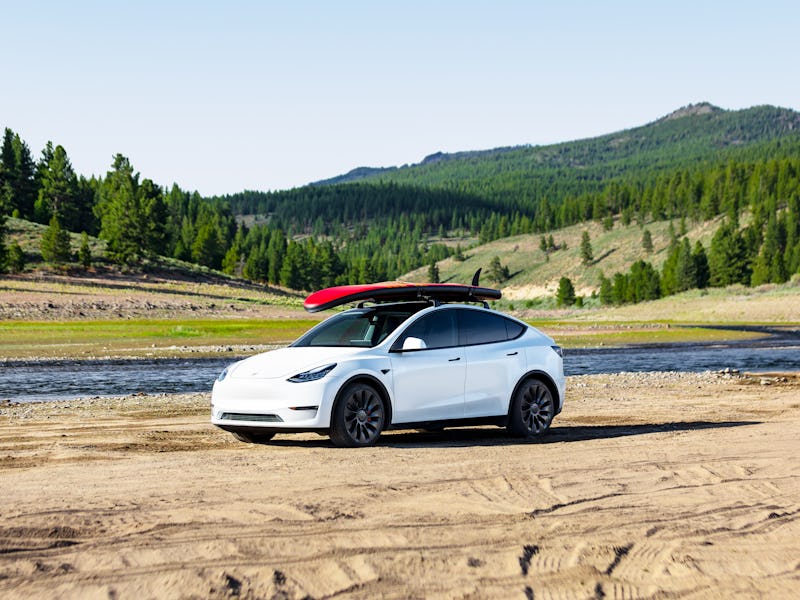Tesla Model Y: Elon Musk teases ‘new design’ to reach even more buyers
Elon Musk seems happy to change the vehicle’s design to reach new customers.

Some say you shouldn’t fix what ain’t broke, but Elon Musk doesn’t seem to want to settle. The already commercially successful Tesla Model Y is getting a redesign, and it could enable the firm’s mass-market car to reach more buyers than ever.
During the company’s second-quarter 2021 earnings call this week, CEO Elon Musk explained that the firm would roll out a “new design” of the all-electric compact SUV by the end of 2021.
The new car will feature a cast front and rear body and — assuming tests are successful — a new, structural battery pack that features Tesla’s radically improved cells.
The Model Y is part of Tesla’s plan to transition from a niche automaker to a mass-market firm. That move started with the release of the Model 3 compact sedan in 2017 and continued with the release of the Model Y in 2020. The transition will be deemed complete when the Cybertruck finally hits the road, maybe in 2021 or 2022.
Want to know more about Musk’s plans for the Cybertruck, the state of battery production at Tesla, and what comes next? Read the full transcript for Tesla’s second-quarter earnings call, only in MUSK READS+.
Tesla Model Y: When is the redesigned SUV’s release date?
During the earnings call, Musk says that “we expect to be producing the new design of the Model Y in both factories in limited production later this year.”
In this case, “both factories” refers to two new Tesla production facilities that are still under construction in the Texas city of Austin and Berlin, Germany.
The Berlin factory is expected to produce around 500,000 Model 3 and Model Y vehicles per year. For context, Tesla produced 454,932 Model 3 and Model Y vehicles last year.
In the call, Musk talks about the “agony” of ramping up production to faster speeds, and describes the process as “insanely difficult”:
“It’s hard to sort of explain to people who have not been through the agony of a manufacturing ramp. Like, why can’t you just turn it on and make, you know, 5,000 a week?...There are 10,000 unique parts and processes that have to work. And the rate of growth of production goes as fast as the least lucky and dumbest of those 10,000 things. And a bunch of them are not even in our control. So it’s insanely difficult.”
Musk would know: Tesla has a track record of production and rollout going awry. Take the Model 3: Tesla started producing the Model 3 in limited quantities in July 2017, intending to produce 5,000 cars per week by December 2017. Instead, the firm reached this figure in June 2018, following a period Musk described as “production hell.”
The Tesla Model Y from above.
Tesla Model Y: What is new in the redesign?
Externally, the new car should look very similar to the Model Y Tesla fans already know and love. In the call, Musk says the car “will look very much like the Model Ys we currently make.”
The difference lies in the production methods themselves. The cars will be made using a new casting process. Current Model Y Teslas roll out of the California factory with a cast rear body only, but the new model to be made in Texas will feature both a cast front and rear body.
The fully cast body is a big achievement for Tesla’s manufacturing processes, which began with the rear body part. Instead of building the car’s rear end out of 70 individual components, for example, the firm can stamp it as a single part using a giant pressing machine.
The first of these machines, a “Giga Press,” started working at Tesla’s California factory late last year. The machines are produced by Italian firm Idra Group, which claims the Giga Press is the biggest of its kind in the world. Each press provides a force of between 5,500 tons and 6,200 tons.
Besides extending this manufacturing process to the vehicle’s entire body, the new car will also feature Tesla’s advanced 4680 battery cells. These battery cells were first detailed at the firm’s September 2020 Battery Day. Tesla promises they will give users a 54 percent increase in battery range between charges and a 56 percent reduction in price per kilowatt-hour.
Part of this new technology involves building the batteries into the car’s structure. Consequently, the firm will use 370 fewer parts per car, and each car will be 10 percent lighter in mass.
As the cells are still under development, Tesla has a backup plan to switch the cars to their standard cells if there are too many delays.
TO READ THE FULL TRANSCRIPT, SUBSCRIBE TO MUSK READS+.
Here is what you will gain from subscribing to MUSK READS+:
- Three emails per week, enabling fans to go deeper into the week’s news.
- Original interviews and reporting, long-form analysis, previews, and recaps of major events, including earnings calls and more.
- Community-focused extras like responses to reader mail, an upcoming event calendar, and notable anniversaries.
- An archive of previous subscriber-only content, so you can easily read back over what you might have missed.
- Promotional deals and offers.
- Supporting original, independent journalism.
MUSK READS+ is a fully independent operation. We are not Elon Musk, nor are we employed by him. Our job is to report the events we find newsworthy, giving you an inside look at the worlds of space rockets, electric cars, clean energy, and more. It means first-hand accounts of a SpaceX rocket launch, Tesla insights from third-party analysts, and more.
If you want to support us in our mission, and receive original interviews and analysis, consider contributing with a subscription.
This article was originally published on